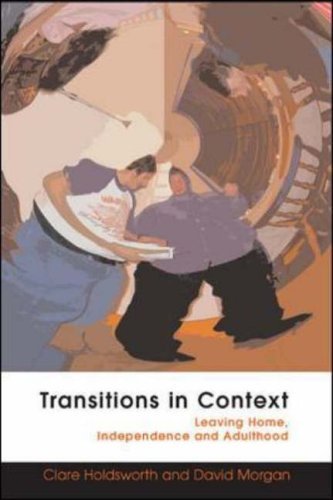Transitions in Context: Leaving Home, Independence and Adulthood
Holdsworth, Clare and Morgan, David
Open University Press, Buckingham
2005
0335215386 (pb)
£19.99
184 pp.
 In this book, Clare Holdsworth and David Morgan analyse young people's transitions towards leaving home, based on empirical data from qualitative interviews with 58 young people and their parents, collected in three national contexts: the UK (Liverpool), Norway (Trondheim) and Spain (Bilbao). Presenting this transition as highly significant within the lifecourse, they explore how leaving home is experienced across place and time, and at an individual and national level. The authors assess that leaving home is no longer intrinsically related to other life changes, such as going to university, getting a job or getting married, and even in instances where these combine, the experience of leaving home is of central importance. Leaving home is shown to be a time where young people are positioned between the dichotomies of child / adult, parents' home / own home, dependence / independence and irresponsibility / responsibility, although this is not necessarily an uncomfortable position, but rather, a time of freedom from constraint. Transitions out of the parental home are presented as important issues in and of themselves, linking to debates surrounding movement away from standardised biographies and towards individualisation.
In this book, Clare Holdsworth and David Morgan analyse young people's transitions towards leaving home, based on empirical data from qualitative interviews with 58 young people and their parents, collected in three national contexts: the UK (Liverpool), Norway (Trondheim) and Spain (Bilbao). Presenting this transition as highly significant within the lifecourse, they explore how leaving home is experienced across place and time, and at an individual and national level. The authors assess that leaving home is no longer intrinsically related to other life changes, such as going to university, getting a job or getting married, and even in instances where these combine, the experience of leaving home is of central importance. Leaving home is shown to be a time where young people are positioned between the dichotomies of child / adult, parents' home / own home, dependence / independence and irresponsibility / responsibility, although this is not necessarily an uncomfortable position, but rather, a time of freedom from constraint. Transitions out of the parental home are presented as important issues in and of themselves, linking to debates surrounding movement away from standardised biographies and towards individualisation.
It was particularly fascinating to see how Holdsworth and Morgan's respondents defined the concepts of independence and adulthood. Whilst some of the young people left home in their late teens or early twenties (particularly in the UK and Norway), others remained in the family home until they were in their thirties, and this had significant implications for their definitions of youth, adulthood and maturity. The young people spoke of independence not only in terms of being able to support oneself financially, but also as being self-reliant and able to act without other people's input. Moreover, independence was viewed differently between these three locations, with young people in Liverpool and Trondheim defining independence as freedom from parental constraint, whereas those in Bilbao saw living in their family homes as not necessarily restrictive. There was not necessarily a link, then, between a perception of oneself as independent and moving away from one's family home. Additionally, adulthood was an uncertain category for many of the young people, who saw becoming an adult as a process, which they had not yet completed, with links being drawn between being an adult and having a settled life of routine and boredom.
I was also interested in the authors' suggestion that leaving home transitions should be seen as an extended concept rather than a one-off event. Young people often make multiple moves away from and back to the family home before finally establishing their own independent household. This was often considered by respondents as 'living away from home', rather than leaving home. This links to the spatial aspects of leaving, which the authors discuss in relation to where young people consider their home to be, and how one goes about the process of creating a home. 'Home' is seen as both practical (a place to live) and symbolic, with the images which respondents had of an ideal home being as important as, if not more important than, the actual experience of creating a home. This further illustrates the fluidity, flexibility and uncertainty which many young people experience in current times, relating to the transition of leaving their parental home and creating their own home.
This book is written in a readable and accessible style, and could be used by undergraduates as well as PhD students and researchers in this field. I have only a couple of issues with it – firstly, young people from cities with their own specific histories and cultures are referred to as the 'British', 'Norwegian' and 'Spanish' respondents, as though they are representative of all young people from these countries. This takes little account of regional variations within each country, and I feel that generalisation on this scale is slightly problematic. Secondly, the focus on differences in national context has led to a marginalisation of other areas of difference such as gender, which is mentioned a number of times as having had an impact on transitions but is rarely mentioned when comparing respondents in this study. However, these criticisms should not detract from what is an interesting and insightful book, which comprehensively illustrates and explains the diversity of experiences and greater uncertainty, which is now present in the (often extended) transition towards leaving home.
Helen Marson
University of Warwick

